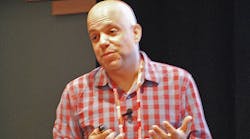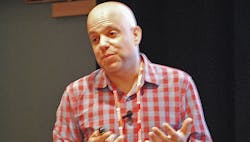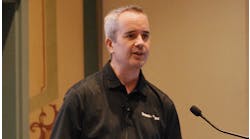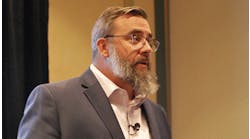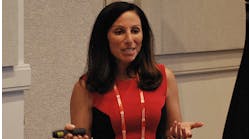“If I need to develop a new module, if I need to make changes, I don’t need anybody at the factory.” Microsoft’s Danilo Diaz explained how Azure and FactoryTalk Edge Gateway work together to manage and contextualize data.
Salma Ghafoor, global technical lead for IoT at Rockwell Automation, was joined by Danilo Diaz, technical director of Azure IoT solutions for Microsoft, at ROKLive to discuss, “Collaborating with Microsoft at the Edge to Map the Next Frontier of Industrial Digital Transformation.” Together, the two create the intelligent edge with Rockwell’s FactoryTalk Edge Gateway, which can contextualize data at the edge, and Microsoft’s Azure IoT Hub and Azure IoT Edge, which serve as the conduit for edge-to-cloud data. Ghafoor and Diaz outlined how this setup can manage and contextualize data down at the edge all the way up to cloud-enabled insights, helping customers define IT/OT convergence at their plants and analyze data at the component level. “Together we can deliver new benefits and new capabilities for the industry,” Ghafoor said.
She said more and more customers are realizing the value of the cloud. “With the combination of an intelligent cloud and AI, you can pretty much deliver any type of intelligent application or system that you can image,” Ghafoor said. With intelligence at the edge, users can get real-time insights delivered by highly responsive and contextually aware applications.
“The virtual, limitless computing power that you get in the cloud with intelligent devices at the edge is a great framework for building immersive and impactful business solutions,” Ghafoor said.
Most manufacturing facilities receive data from many sources, such as programmable logic controllers (PLCs), intelligent devices or sensors, and it can be complicated to manage all that data. “Once we have that data, what we then need is a way to send that data in a secure and scalable way up to the cloud,” Ghafoor said. “You can use Edge Gateway to gather the data, and your IoT Edge will then connect to it and allow you to send that to the cloud.”
The edge-to-cloud system can also streamline the development process. “IT does not know where the data is because they don’t have that domain knowledge,” Ghafoor said. Operations technology (OT) has the needed knowledge. “Rather than IT looking for the data, OT can actually package it up and send it over to IT,” Ghafoor said. Edge Gateway allows the controls engineer to identify and contextualize datasets right down at the controls level; the datasets are then extracted in such a way that they can be easily and quickly used by the cloud applications.
Traditionally, when you change the underlying equipment in the process, anything that’s built on top of that also needs to be redesigned, but this system changes that process. “You build a model once, and it can be sent to multiple different endpoints,” Ghafoor said. More can be done by the OT crew on the plant floor. When updates are made to the information model at the Edge Gateway, that will then automatically get synchronized and sent up to the cloud. This increases engineering efficiency for project development.
Rather than building models up in the cloud, controls engineers can build them at the edge. “It also means that we can easily deploy these because it’s within the domain of our team,” Ghafoor said. Collaboration between departments is no longer needed, and OT can manage the data and the models. “It also ensures that you have a single source of truth because you’re building the dataset once and then leveraging it multiple times,” Ghafoor said. “Once we have the models and we have the data streaming into them, we can map that out to multiple different enterprise and cloud applications.”
The Edge Gateway information model also provides organizational context, showing tags and the area where the information is coming from. “It makes it much easier when you’re developing your analytic solutions because the data is already labeled,” Ghafoor said. This will also help reduce development time. Edge Gateway is streaming real-time series data into the model and not just the data, also the information context, as well. “That’s the key differentiator,” Ghafoor said.
Microsoft’s IoT Edge is the software component, allowing the deployment of different modules and different functionality into an edge device, said Microsoft’s Diaz. “Everything on IoT Edge is done with security in mind,” he said. In part, this is why it’s based on open standards, Diaz said, which have wider adoption. It’s also open source, so facilities can modify it if they like. The system is also cross-platform and works on Windows and Linux.
The functionality that’s available in the field can also be managed through the cloud, Diaz said. “So that means that if I need to develop a new module, if I need to make changes, I don’t need anybody at the factory,” he said.
It is also ISA-95-compliant. Under the Purdue model, layers in an industrial control system help reduce the damage if security is breached. “You’re reducing your danger zone,” Diaz said. “IoT Edge supports that architecture.”
IoT Hub is an interface between the edge and the cloud, which is part of the Azure platform. “Azure is a cloud platform that has many building blocks, and these building blocks allow you to build a complete solution,” Diaz said.
Data can also be stored on the cloud inexpensively, Diaz said. “You can train your model so yesterday’s noise becomes the base insights,” he added. He recommends keeping at least a couple months of data on the cloud, so once an anomaly is detected, the system can determine if that issue has happened before.
“We don’t have something that we can sell you out of the box to run your plant,” Diaz said. For that, Microsoft has partnered with Rockwell. “We want to enable our partners to build the best manufacturing solutions,” Diaz said. The Microsoft platform provides the building blocks for manufacturers to create many solutions for cybersecurity, predictive maintenance or supply-chain visibility, and leveraging connected field service or remote monitoring.
“The Azure platform allows partners like Rockwell to build meaningful solutions; our customers take advantage of the platform to extend even what our partners are doing,” Diaz said.
The editors of Control, Control Design and Smart Industry are reporting live from ROKLive 2022 in Orlando, Florida, to bring you the latest news and insights from the event. When the event comes to a close, the best, most important coverage will be compiled into a report by the editors.
Register now to pre-order the report and be among the first to receive it in your inbox.
